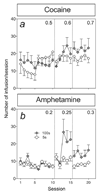The rate of intravenous cocaine or amphetamine delivery does not influence drug-taking and drug-seeking behavior in rats
- PMID: 18586051
- PMCID: PMC2576488
- DOI: 10.1016/j.pbb.2008.06.003
The rate of intravenous cocaine or amphetamine delivery does not influence drug-taking and drug-seeking behavior in rats
Abstract
We studied the influence of rate of intravenous infusion of cocaine or amphetamine on drug-taking and seeking behavior. First, drug-naive rats were tested for acquisition of self-administration of increasing doses of amphetamine or cocaine infused over 5 or 100 s. Second, self-administration of cocaine or amphetamine infused over 5-100 s was assessed on fixed or progressive-ratio (PR) reinforcement schedules. Finally, the ability of a single 5 or 100 s amphetamine or cocaine infusion to reinstate extinguished drug seeking was assessed. Although slower infusion rates produced a small effect on drug taking under continuous-reinforcement conditions, infusion rate did not alter drug taking on intermittent or PR reinforcement schedules, or the ability of cocaine or amphetamine to reinstate drug seeking. Taken together, our results suggest that variation in drug delivery rate over a range that we previously found alters the induction of behavioral sensitization, gene-expression and striatal dopamine activity, does not markedly alter drug-taking or seeking behavior.
Figures





Similar articles
-
Neonatal isolation enhances maintenance but not reinstatement of cocaine self-administration in adult male rats.Psychopharmacology (Berl). 2005 Feb;177(4):391-9. doi: 10.1007/s00213-004-1963-y. Epub 2004 Jul 16. Psychopharmacology (Berl). 2005. PMID: 15258719
-
Regulation of medial prefrontal cortex dopamine by alpha-amino-3-hydroxy-5-methylisoxazole-4-propionate/kainate receptors.Neuroscience. 2002;114(2):507-16. doi: 10.1016/s0306-4522(02)00276-2. Neuroscience. 2002. PMID: 12204218
-
Previous exposure to VTA amphetamine enhances cocaine self-administration under a progressive ratio schedule in a D1 dopamine receptor dependent manner.Neuropsychopharmacology. 2002 Dec;27(6):970-9. doi: 10.1016/S0893-133X(02)00379-2. Neuropsychopharmacology. 2002. PMID: 12464454
-
Acquisition, maintenance and reinstatement of intravenous cocaine self-administration under a second-order schedule of reinforcement in rats: effects of conditioned cues and continuous access to cocaine.Psychopharmacology (Berl). 1998 Dec;140(3):331-44. doi: 10.1007/s002130050774. Psychopharmacology (Berl). 1998. PMID: 9877013
-
WITHDRAWN: Psychosocial interventions for cocaine and psychostimulant amphetamines related disorders.Cochrane Database Syst Rev. 2015 Apr 2;2015(4):CD003023. doi: 10.1002/14651858.CD003023.pub3. Cochrane Database Syst Rev. 2015. PMID: 25835305 Free PMC article.
Cited by
-
Intrathecal cocaine delivery enables long-access self-administration with binge-like behavior in mice.Psychopharmacology (Berl). 2011 Jan;213(1):119-29. doi: 10.1007/s00213-010-2021-6. Epub 2010 Sep 23. Psychopharmacology (Berl). 2011. PMID: 20862455
-
Rats markedly escalate their intake and show a persistent susceptibility to reinstatement only when cocaine is injected rapidly.J Neurosci. 2010 Aug 25;30(34):11346-55. doi: 10.1523/JNEUROSCI.2524-10.2010. J Neurosci. 2010. PMID: 20739555 Free PMC article.
-
The self-administration of rapidly delivered cocaine promotes increased motivation to take the drug: contributions of prior levels of operant responding and cocaine intake.Psychopharmacology (Berl). 2014 Oct;231(21):4241-52. doi: 10.1007/s00213-014-3576-4. Epub 2014 Apr 22. Psychopharmacology (Berl). 2014. PMID: 24752656
-
Cues paired with either rapid or slower self-administered cocaine injections acquire similar conditioned rewarding properties.PLoS One. 2011;6(10):e26481. doi: 10.1371/journal.pone.0026481. Epub 2011 Oct 19. PLoS One. 2011. PMID: 22039496 Free PMC article.
-
Amphetamine potency varies with dopamine uptake rate across striatal subregions.J Neurochem. 2014 Nov;131(3):348-55. doi: 10.1111/jnc.12808. Epub 2014 Jul 30. J Neurochem. 2014. PMID: 24988947 Free PMC article.
References
-
- Abreu ME, Bigelow GE, Fleisher L, Walsh SL. Effect of intravenous injection speed on responses to cocaine and hydromorphone in humans. Psychopharmacology (Berl) 2001;154:76–84. - PubMed
-
- Amsel A. Frustrative nonreward in partial reinforcement and discrimination learning: some recent history and a theoretical extension. Psychol Rev. 1962;69:306–328. - PubMed
-
- Berger B, Gaspar P, Verney C. Dopaminergic innervation of the cerebral cortex: unexpected differences between rodents and primates. Trends Neurosci. 1991;14:21–27. - PubMed
-
- Brown PL, Kiyatkin EA. Brain temperature change and movement activation induced by intravenous cocaine delivered at various injection speeds in rats. Psychopharmacology (Berl) 2005;181:299–308. - PubMed
MeSH terms
Substances
Grants and funding
LinkOut - more resources
Full Text Sources
Medical
Research Materials

